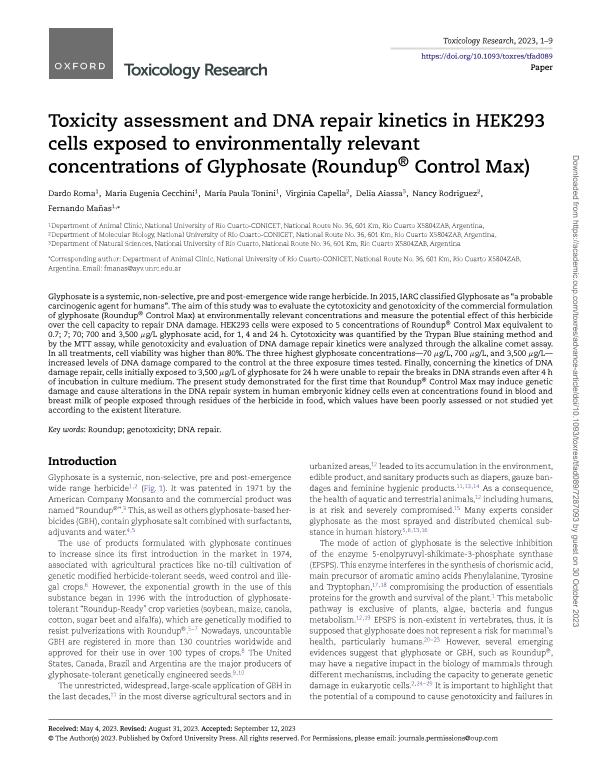Mostrar el registro sencillo del ítem
dc.contributor.author
Roma, Dardo Andrés

dc.contributor.author
Cecchini, Maria Eugenia

dc.contributor.author
Tonini, Maria Paula

dc.contributor.author
Capella, Virginia

dc.contributor.author
Aiassa, Delia Elba

dc.contributor.author
Rodriguez, Nancy
dc.contributor.author
Mañas, Fernando Javier

dc.date.available
2024-02-14T12:48:46Z
dc.date.issued
2023-09
dc.identifier.citation
Roma, Dardo Andrés; Cecchini, Maria Eugenia; Tonini, Maria Paula; Capella, Virginia; Aiassa, Delia Elba; et al.; Toxicity assessment and DNA repair kinetics in HEK293 cells exposed to environmentally relevant concentrations of Glyphosate (Roundup® Control Max); Oxford University Press; Toxicology Research; 12; 5; 9-2023; 970-978
dc.identifier.issn
2045-4538
dc.identifier.uri
http://hdl.handle.net/11336/226786
dc.description.abstract
Glyphosate is a systemic, non-selective, pre and post-emergence wide range herbicide. In 2015, IARC classified Glyphosate as “a probable carcinogenic agent for humans”. The aim of this study was to evaluate the cytotoxicity and genotoxicity of the commercial formulation of glyphosate (Roundup® Control Max) at environmentally relevant concentrations and measure the potential effect of this herbicide over the cell capacity to repair DNA damage. HEK293 cells were exposed to 5 concentrations of Roundup® Control Max equivalent to 0.7; 7; 70; 700 and 3,500 μg/L glyphosate acid, for 1, 4 and 24 h. Cytotoxicity was quantified by the Trypan Blue staining method and by the MTT assay, while genotoxicity and evaluation of DNA damage repair kinetics were analyzed through the alkaline comet assay. In all treatments, cell viability was higher than 80%. The three highest glyphosate concentrations—70 μg/L, 700 μg/L, and 3,500 μg/L—increased levels of DNA damage compared to the control at the three exposure times tested. Finally, concerning the kinetics of DNA damage repair, cells initially exposed to 3,500 μg/L of glyphosate for 24 h were unable to repair the breaks in DNA strands even after 4 h of incubation in culture medium. The present study demonstrated for the first time that Roundup® Control Max may induce genetic damage and cause alterations in the DNA repair system in human embryonic kidney cells even at concentrations found in blood and breast milk of people exposed through residues of the herbicide in food, which values have been poorly assessed or not studied yet according to the existent literature.
dc.format
application/pdf
dc.language.iso
eng
dc.publisher
Oxford University Press

dc.rights
info:eu-repo/semantics/openAccess
dc.rights.uri
https://creativecommons.org/licenses/by-nc-sa/2.5/ar/
dc.subject
DNA REPAIR
dc.subject
GENOTOXICITY
dc.subject
ROUNDUP
dc.subject.classification
Otros Tópicos Biológicos

dc.subject.classification
Ciencias Biológicas

dc.subject.classification
CIENCIAS NATURALES Y EXACTAS

dc.title
Toxicity assessment and DNA repair kinetics in HEK293 cells exposed to environmentally relevant concentrations of Glyphosate (Roundup® Control Max)
dc.type
info:eu-repo/semantics/article
dc.type
info:ar-repo/semantics/artículo
dc.type
info:eu-repo/semantics/publishedVersion
dc.date.updated
2024-02-14T11:47:11Z
dc.journal.volume
12
dc.journal.number
5
dc.journal.pagination
970-978
dc.journal.pais
Reino Unido

dc.journal.ciudad
Oxford
dc.description.fil
Fil: Roma, Dardo Andrés. Universidad Nacional de Río Cuarto. Facultad de Agronomía y Veterinaria. Departamento de Clínica Animal; Argentina. Consejo Nacional de Investigaciones Científicas y Técnicas. Centro Científico Tecnológico Conicet - Córdoba; Argentina
dc.description.fil
Fil: Cecchini, Maria Eugenia. Universidad Nacional de Río Cuarto. Facultad de Agronomía y Veterinaria. Departamento de Clínica Animal; Argentina. Consejo Nacional de Investigaciones Científicas y Técnicas. Centro Científico Tecnológico Conicet - Córdoba; Argentina
dc.description.fil
Fil: Tonini, Maria Paula. Universidad Nacional de Río Cuarto. Facultad de Agronomía y Veterinaria. Departamento de Clínica Animal; Argentina
dc.description.fil
Fil: Capella, Virginia. Universidad Nacional de Río Cuarto. Facultad de Ciencias Exactas Fisicoquímicas y Naturales. Instituto de Investigaciones en Tecnologías Energéticas y Materiales Avanzados. - Consejo Nacional de Investigaciones Científicas y Técnicas. Centro Científico Tecnológico Conicet - Córdoba. Instituto de Investigaciones en Tecnologías Energéticas y Materiales Avanzados; Argentina
dc.description.fil
Fil: Aiassa, Delia Elba. Universidad Nacional de Río Cuarto. Facultad de Agronomía y Veterinaria. Departamento de Clínica Animal; Argentina
dc.description.fil
Fil: Rodriguez, Nancy. Universidad Nacional de Río Cuarto. Facultad de Agronomía y Veterinaria. Departamento de Clínica Animal; Argentina
dc.description.fil
Fil: Mañas, Fernando Javier. Universidad Nacional de Río Cuarto. Facultad de Agronomía y Veterinaria. Departamento de Clínica Animal; Argentina. Consejo Nacional de Investigaciones Científicas y Técnicas. Centro Científico Tecnológico Conicet - Córdoba; Argentina
dc.journal.title
Toxicology Research
dc.relation.alternativeid
info:eu-repo/semantics/altIdentifier/url/https://academic.oup.com/toxres/advance-article/doi/10.1093/toxres/tfad089/7287093
dc.relation.alternativeid
info:eu-repo/semantics/altIdentifier/doi/http://dx.doi.org/10.1093/toxres/tfad089
Archivos asociados
